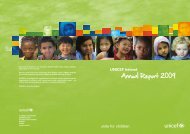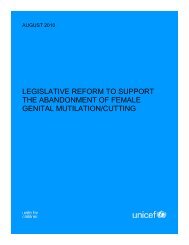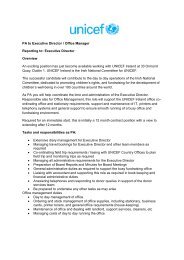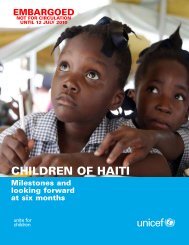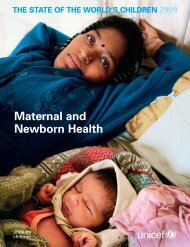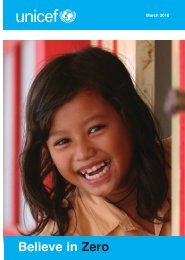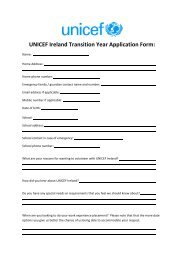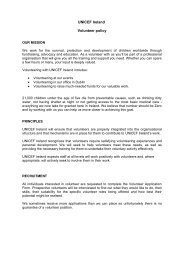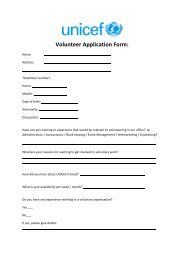Humanitarian Action for Children 2011 - Unicef
Humanitarian Action for Children 2011 - Unicef
Humanitarian Action for Children 2011 - Unicef
- No tags were found...
You also want an ePaper? Increase the reach of your titles
YUMPU automatically turns print PDFs into web optimized ePapers that Google loves.
Chad<strong>Humanitarian</strong>funding at work:Highlights from 2010In 2010, UNICEF estimated thatUS$51,237,840 was needed tofund its humanitarian work inChad. As of October 2010, atotal of US$18,801,849 had beenreceived, representing 37 percent of the request. With thislevel of funding, UNICEF wasable to improve the lives ofchildren facing health and nutritionrisks due to displacementand chronic food shortages.UNICEF supported increasedcoverage of immunization from23 per cent to 95 per cent <strong>for</strong>children under age 1 in the refugeecamps, sites <strong>for</strong> internallydisplaced persons and hostcommunity villages. The numberof children benefiting fromtherapeutic feeding increasedfrom 12,000 in 2009 to 46,000 inNovember 2010, thereby lesseningthe high mortality andmorbidity related to undernutritionthat characterizes the region.During the 2010 rainy season,excessive rain caused floodingin areas typically affected, andin the western and southernareas of the country, the riseof the Chari and Logone Riversthat criss-cross these regionscreated additional hazards. Theextensive flooding helped propela cholera outbreak that affectedmany areas. UNICEF’s technicalassistance and provision of medicalequipment and medicine tothe Government of Chad helpedreduce the overall cholerafatality rate from 19 per cent to3 per cent in Guéra, Kanem, Lac,Mayo-Kebbi East, Mayo-KebbiWest and N’Djamena Regions.<strong>Children</strong> and women in crisisAn estimated 2 million people in Chad are in need of food assistance. For many of them,undernutrition and chronic food insecurity now characterize ‘normal’ life, as food productionacross the Sahel region remains crippled by severe drought, pressure on scarce resourcesand progressive desertification. This hardship has been compounded by civil conflict inneighbouring countries that has caused over 300,000 people from the Darfur region of theSudan and from the Central African Republic to seek refuge in Chad. 1 The same conflict hasdisplaced an estimated 170,000 Chadian residents of border regions with Darfur. 2 Thosewho are displaced or living in refugee camps are highly susceptible to such health risks ascholera, meningitis and measles epidemics. Inadequate access to basic health care, safe waterand sanitation and low levels of routine immunization coverage further compromise healthamong all populations in Chad. In eastern Chad, the recruitment of children into armed groupsremains a critical problem. Concerns <strong>for</strong> the well-being of children and women have increasedwith the departure of the United Nations Mission in the Central African Republic and Chad inNovember 2010.Meeting urgent needs and building resilience in <strong>2011</strong>UNICEF Chad is providing cluster coordination leadership in WASH, nutrition and education.In <strong>2011</strong>, UNICEF will continue to work with the Government of Chad, other UN agencies, NGOsand host communities to address the needs of 2.5 million people, including 300,000 women,765,000 girls and 735,000 boys.• To provide basic health-care services to the most vulnerable populations, UNICEF will ensurethe routine immunization and supplementary vaccination campaigns <strong>for</strong> polio, meningitis,measles and tetanus, with a goal of reaching all 2.6 million children in the country underage 5.• To reduce infant mortality caused by disease, UNICEF will ensure access to safe water,sanitation and improved hygiene <strong>for</strong> 505,000 refugees, internally displaced personsand those in host communities across Chad, particularly in the Sahelian belt and the eastand south.• UNICEF will provide access to quality education <strong>for</strong> 561,000 pre- and primary-schoolagedchildren in eastern and southern Chad by recruiting and training teachers <strong>for</strong> areasseverely impacted by displacement and by constructing 300 learning structures within therefugee camps.• UNICEF will bolster protective services <strong>for</strong> 60,000 internally displaced and refugee children(roughly 50 per cent of them girls) and 240,000 young people (110,000 boys and 130,000 girls)will receive in<strong>for</strong>mation on HIV prevention in schools and youth centres by trained teachersand peer youth educators.Funding requirements <strong>for</strong> <strong>2011</strong>UNICEF is requesting US$45,639,000 <strong>for</strong> its humanitarian activities in Chad during <strong>2011</strong>. Theserequirements are in line with UNICEF requirements in the <strong>2011</strong> Consolidated Appeals Process(CAP). Adequate funding levels are necessary to maximize progress in well-being and development<strong>for</strong> women and children in Chad.More in<strong>for</strong>mation on 2010 achievements and details of humanitarian action planned<strong>for</strong> Chad in <strong>2011</strong> can be found at www.unicef.org/hac<strong>2011</strong>.1. United Nations High Commissioner <strong>for</strong> Refugees, ‘2010 UNHCR Country Operations Profile: Chad’, UNHCR,Geneva, , accessed 14 December 2010.2. United Nations, “Chad: <strong>2011</strong> Consolidated Appeal”, Office <strong>for</strong> the Coordination of <strong>Humanitarian</strong> Affairs, NewYork, November 2010, p. 1.UNICEF EMERGENCY NEEDS FOR <strong>2011</strong> (in US dollars)Total $45,639,0003,225,000Health6,010,000Child protection2,200,000HIV and AIDS15,300,000 Nutrition8,120,000 WASH10,354,000Education430,000Cluster coordinationChadwww.unicef.org/hac<strong>2011</strong> | <strong>2011</strong> UNICEF <strong>Humanitarian</strong> <strong>Action</strong> FOR CHILDREN 65




